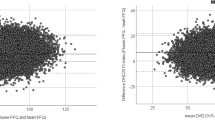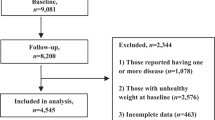Abstract
Backgrounds/Objectives:
The aim of this paper is to verify the performance of the frequency of consumption as variable for prediction of the usual intakes of foods.
Subjects/Methods:
In total, 725 individuals who answered two nonconsecutive 24-h recall and one food frequency questionnaire (FFQ) in the ‘Healthy Survey-Sao Paulo-Brazil’. An additional indicator variable indicating if one is usual consumer was created before analyzing. The Multiple Source Method and National Cancer Institute method were used to estimate usual intake of selected food considering different models of prediction: with no covariates; with FFQ; with FFQ plus indicator variable; and with only indicator variable.
Results:
For foods that are consumed every day or almost every day, the inclusion of the FFQ and/or the indicator variable as covariates resulted in similar percentiles of consumption when compared with the model with no covariates. For episodically consumed foods, the models with FFQ plus indicator variable and with only indicator variable estimated similar percentiles of intake.
Conclusions:
The use of the indicator variable instead the FFQ appears as a good alternative to estimate usual intake of episodically consumed foods.
This is a preview of subscription content, access via your institution
Access options
Subscribe to this journal
Receive 12 print issues and online access
$259.00 per year
only $21.58 per issue
Buy this article
- Purchase on Springer Link
- Instant access to full article PDF
Prices may be subject to local taxes which are calculated during checkout
Similar content being viewed by others
References
Nusser SM, Carriquiry AL, Dodd KW, Fuller WA . A semiparametric transformation approach to estimating usual daily intake distributions. J Am Stat Assoc 1996; 91: 1440–1449.
Moshfegh AJ, Rhodes DG, Baer DJ, Murayi T, Clemens JC, Rumpler WV et al. The US Department of Agriculture Automated Multiple-Pass Method reduces bias in the collection of energy intakes. Am J Clin Nutr 2008; 88: 324–332.
Beaton GH, Milner J, Corey P, McGuire V, Cousins V, Stewart E et al. Source of variation in 24-hour dietary recall data: implications for nutrition study design and interpretation. Am J Clin Nutr 1979; 32: 2546–2459.
Dodd KW, Guenther PM, Freedman LS, Subar AF, Kipnis V, Midthune D et al. Statistical methods for estimating usual intake of nutrients and foods: a review of the theory. J Am Diet Assoc 2006; 106: 1640–1650.
Tooze JA, Midthune D, Dodd KW, Freedman LS, Krebs-Smith SM, Subar AF et al. A new statistical method for estimating the usual intake of episodically consumed foods with application to their distribution. J Am Diet Assoc 2006; 106: 1575–1587.
Hartig U, Haubrock J, Knüppel S, Boeing H et al. The MSM program: web-based statistics package for estimating usual dietary intake using the Multiple Source Method. Eur J Clin Nutr 2011; 65: S87–S91.
Kipnis V, Midthune D, Buckman DW, Dodd KW, Guenter PM, Krebs-Smith SM et al. Modeling data with excess zeros and measurement error: application to evaluating relationship between episodically consumed foods and health outcomes. Biometrics 2009; 65: 1003–1010.
Subar A, Dodd KW, Guenther PM, Kipnis V, Midthune D, McDowell M et al. The Food Propensity Questionnaire: concept, development, and validation for use as a covariate in a model to estimate usual food intake. J Am Diet Assoc 2006; 106: 1556–1563.
Souverein OW, Dekkers AL, Geelen A, Haubrock J, Vries JH, Ocké MC et al. Comparing four methods to estimate usual intake distriburtions. Eur J Clin Nutr 2011; 65: S92–S101.
Sousa CA, Cesar CLG, Barros MBA, Carandina L, Goldbaum M, Pereira JCR . Prevalence of chronic obstructive pulmonary disease and risk factors in São Paulo, Brazil, 2008–2009. Rev Saúde Pública 2011; 45: 887–896.
Verly-Jr E, Castro MA, Fisberg RM, Marchioni DML . Precision of usual food intake estimates according to the percentage of individuals with a second dietary measurement. J Am Nut Diet 2012; 112: 1015–1020.
Fisberg RM, Colucci AC, Morimoto JM, Marchioni DM . Food frequency questionnaire for adults from a population-based study. Rev Saude Publica 2008; 42: 550–554.
Drewnowski A . Diet Image: A New Perspective On The Food-Frequency Questionnaire. Nutr Rev 2001; 59: 370–374.
Acknowledgements
This study was financially supported by the Fundação de Amparo à Pesquisa do Estado de São Paulo (FAPESP—procedural n° 2009/11239-9 and 2009/15831-0) and Conselho Nacional de Desenvolvimento Científico e Tecnológico (CNPq—procedural n° 503128/2010-4).
Author information
Authors and Affiliations
Corresponding author
Ethics declarations
Competing interests
The authors declare no conflict of interest.
Rights and permissions
About this article
Cite this article
Verly-, E., Fisberg, R. & Marchioni, D. Is the food frequency consumption essential as covariate to estimate usual intake of episodically consumed foods?. Eur J Clin Nutr 66, 1254–1258 (2012). https://doi.org/10.1038/ejcn.2012.119
Received:
Revised:
Accepted:
Published:
Issue Date:
DOI: https://doi.org/10.1038/ejcn.2012.119
Keywords
This article is cited by
-
Biodiversity is overlooked in the diets of different social groups in Brazil
Scientific Reports (2023)



